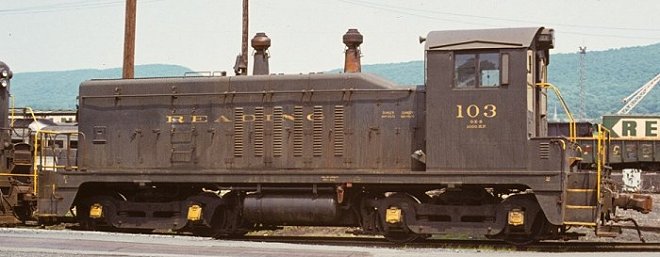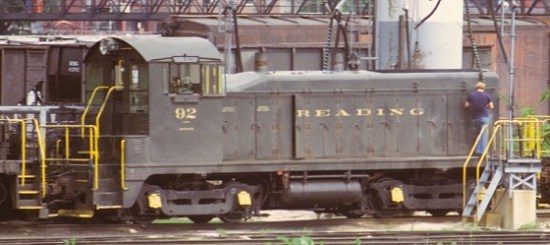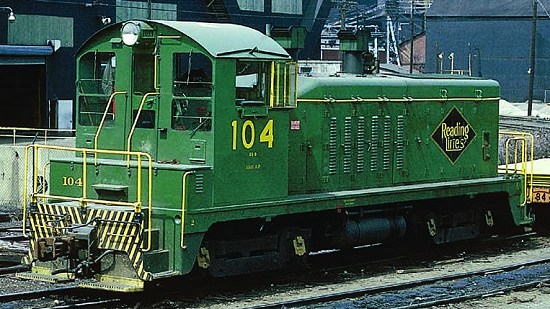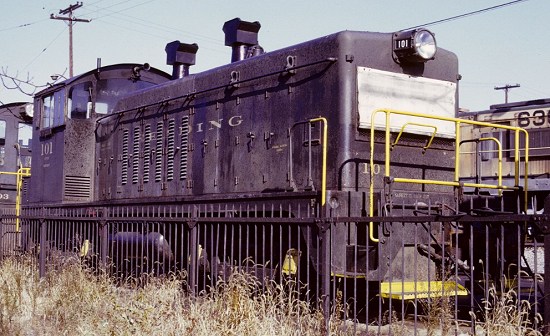EMD: NW-2

 In September, 1940, the Reading took delivery of its first 1000-horsepower EMD switcher, NW2 (Nine hundred horsepower, Welded frame) #90. Sister units #91 and #92 would follow in October, 1941, and would be the last locomotives of this class to arrive until after World War II, due to War Production Board restrictions. In 1947, the five remaining NW2s were delivered, numbered #100 - 104. These units were assigned the Reading class OE-9, and saw service both in the coal regions and the Philadelphia area. NW2s #90-92 were assigned to Newberry Junction upon delivery, and were frequently seen working in Pottsville, while the later units worked in the Philadelphia area.
In September, 1940, the Reading took delivery of its first 1000-horsepower EMD switcher, NW2 (Nine hundred horsepower, Welded frame) #90. Sister units #91 and #92 would follow in October, 1941, and would be the last locomotives of this class to arrive until after World War II, due to War Production Board restrictions. In 1947, the five remaining NW2s were delivered, numbered #100 - 104. These units were assigned the Reading class OE-9, and saw service both in the coal regions and the Philadelphia area. NW2s #90-92 were assigned to Newberry Junction upon delivery, and were frequently seen working in Pottsville, while the later units worked in the Philadelphia area.
 The Reading's NW2 locomotives survived largely untouched until the 1970s, not having been rebuilt or converted into higher horsepower units like some of the railroad's other switchers. Locomotive #104 received the 1970s "Reading Green" paint scheme as shown in the Paul Kutta photo at left; however, it appears to have been a hastily-applied job, as the numbers on the side of the cab do not appear to match. Also, note the mix of Gothic and Roman numerals when comparing the side of the cab to the rear of the locomotive.
The Reading's NW2 locomotives survived largely untouched until the 1970s, not having been rebuilt or converted into higher horsepower units like some of the railroad's other switchers. Locomotive #104 received the 1970s "Reading Green" paint scheme as shown in the Paul Kutta photo at left; however, it appears to have been a hastily-applied job, as the numbers on the side of the cab do not appear to match. Also, note the mix of Gothic and Roman numerals when comparing the side of the cab to the rear of the locomotive.
MODELING NOTES: Reading NW2 #103 has been preserved by the Reading Company Technical & Historical Society, so modelers have the advantage of being able to work from a surviving prototype example. There are several features that make the NW2s unique among Reading EMD switchers. First, the angle of the hood does not meet the cab wall, it slopes down then then returns to horizontal for a few inches before meeting the cab wall. Also, the screen on the front of the locomotive does not extend the full height of the hood as on later switchers. In addition, note the early-style headlights, squared-off railings, lack of a railing along the walkway, and the spark arrestors on the stacks. As can been seen in the photos on this page, some locomotives had different types of arrestors, or none at all. Operationally, the NW2s were seen in Philadelphia and the coal regions, and could be used throughout any time period from 1940 through the early 1970s.

Did You Know?
Downloads
 A variety of Reading Company operations related documents, etc. that may be of use in your modeling efforts.
A variety of Reading Company operations related documents, etc. that may be of use in your modeling efforts.
 A variety of Reading Company operations paperwork, such as train orders, clearance forms, etc. that will help you operate your Reading layout in a prototypical manner.
A variety of Reading Company operations paperwork, such as train orders, clearance forms, etc. that will help you operate your Reading layout in a prototypical manner.
 Public Timetables, Employe Timetables, and Rulebooks that provide much useful operational information.
Public Timetables, Employe Timetables, and Rulebooks that provide much useful operational information.
 Signs, billboards, and other FREE goodies for your use. We ask only that you help spread the word about The Reading Modeler!
Signs, billboards, and other FREE goodies for your use. We ask only that you help spread the word about The Reading Modeler!

